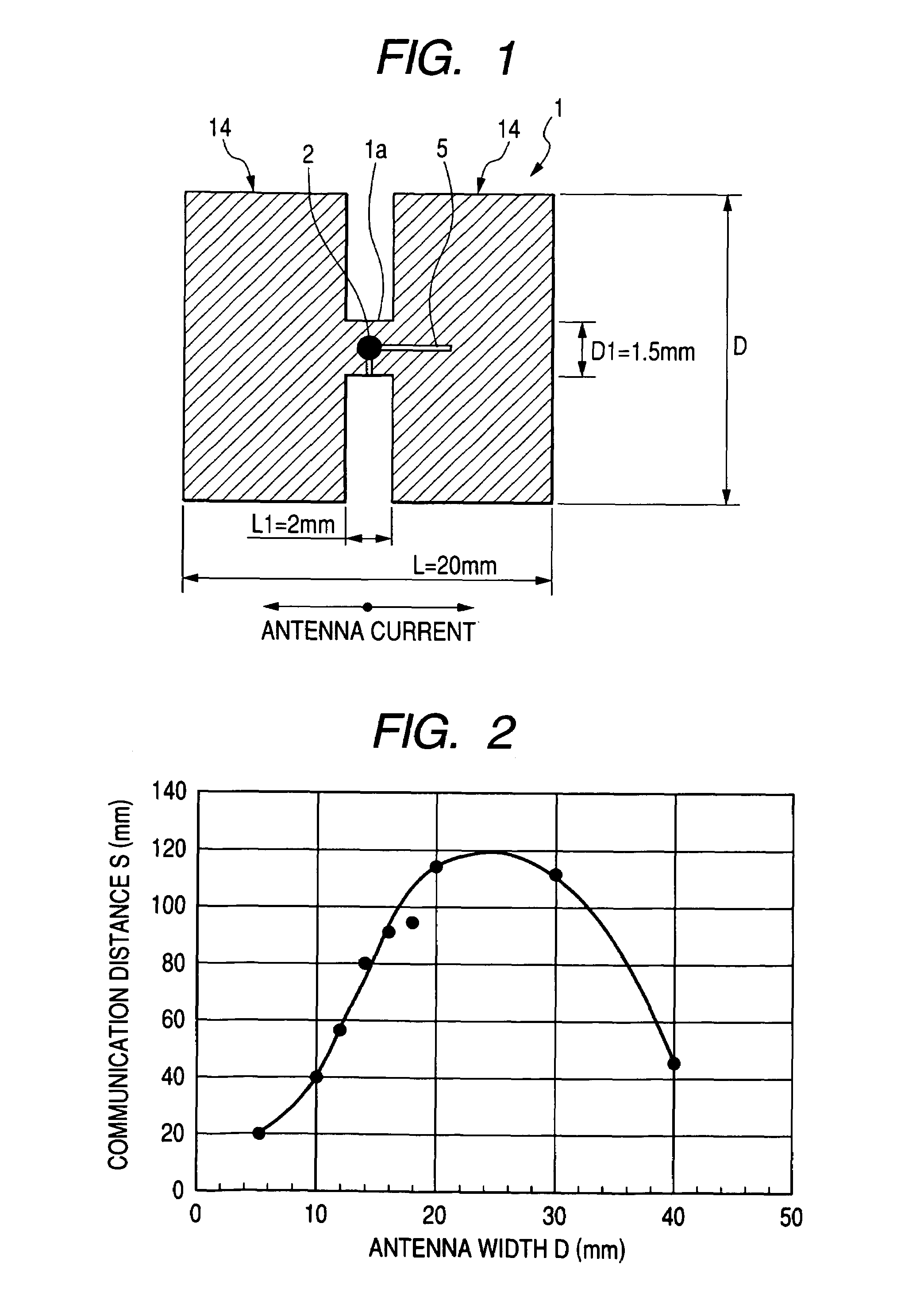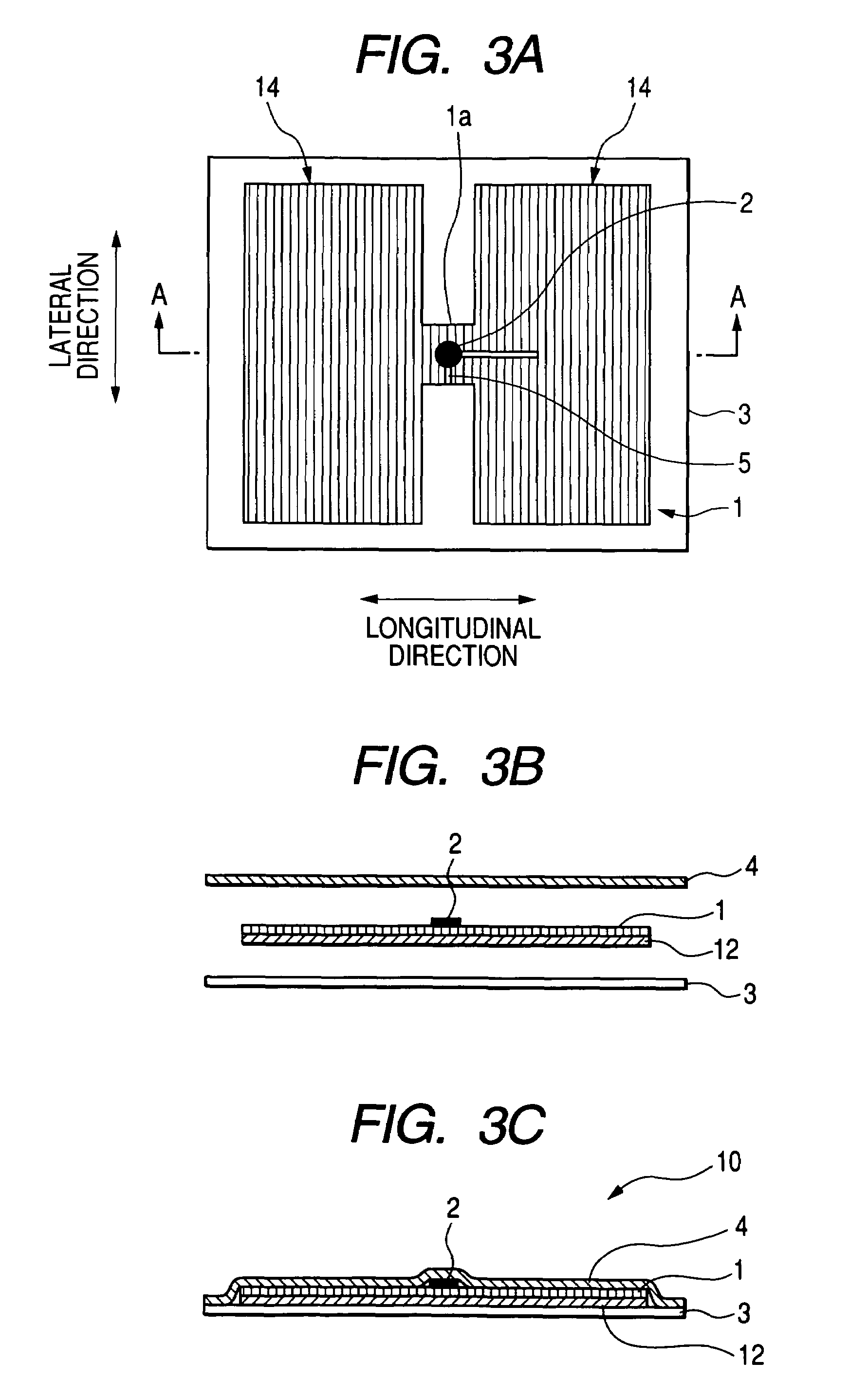Radio frequency IC tag and method for manufacturing the same
a radio frequency ic tag and frequency technology, applied in the direction of printed circuit non-printed electric components, instruments, semiconductor/solid-state device details, etc., can solve the problems of difficult communication, reduced antenna efficiency, and short communication distance, so as to achieve maximum antenna efficiency, increase antenna efficiency, and reduce antenna efficiency.
- Summary
- Abstract
- Description
- Claims
- Application Information
AI Technical Summary
Benefits of technology
Problems solved by technology
Method used
Image
Examples
first embodiment
[0027]FIG. 1 is a plan view illustrating an H type antenna used in a radio frequency IC tag according to a first embodiment of the present invention. As shown in FIG. 1, an H type antenna 1 used in the radio frequency IC tag has a so-called H shape in which the antenna width D1 is narrowed in the central part of the antenna forming a constriction 1a extending in a direction of a length L1 while the antenna width D is widened at both side parts (peripheral radiation parts) 14 of the antenna 1 extending in the direction of the length L. In addition, an IC chip 2 is mounted on the central part of the H type antenna 1. The H type antenna 1 functions as a strip antenna. The H type antenna 1 takes preventive measures against electrostatic discharge damage, and performs impedance matching. Therefore, a consecutive key-shaped (or L-shaped) slit 5 is formed in the central part equipped with the IC chip 2 in such a manner that the IC chip 2 is placed across the slit 5, and the terminals of th...
second embodiment
[0049]FIG. 5 is a plan view illustrating an O type (dumbbell or oval type) antenna used in a radio frequency IC tag according to a second embodiment of the present invention. As shown in FIG. 5, an O type antenna 9 having a generally circular or oval shape has a configuration in which the central part 9a between two pieces of semicircular metal foil 15 having a radius of R is connected with rectangular metal foil having a width of D2. The rectangular metal foil part is equipped with the IC chip 2 to form a radio frequency IC tag. When an antenna current flows from the IC chip 2 of the O type antenna 9 having such a shape toward a direction indicated by an arrow in FIG. 5, the maximum current flows in the central part 9a (the part equipped with the IC chip 2 which forms a power-feeding part), and the antenna current then flows toward semicircular parts 15 at both sides, which act as radiation parts. As a result, the electromagnetic energy of the semicircular parts 15 at both sides su...
third embodiment
[0050]What will be described in this embodiment are some variations of radio frequency IC tags in which the shapes of the H type antenna and of the O type antenna described above are changed. In the embodiments described above, the width of the central part of an antenna extending in the longitudinal direction is narrowed to form an H-shaped or O-shaped antenna, and the radio frequency IC tag is equipped with the IC chip in the central part of the antenna. On the contrary, in a radio frequency IC tag according to a third embodiment, a position at which the IC chip is mounted (that is, a constriction) is moved from the central part of the antenna to a desired position so as to form an H type antenna, or an O type antenna, having a changed shape. In another case, the right and left shapes of an H type antenna or of an O type antenna, or the top and bottom shapes of an H type antenna or of an O type antenna, are made asymmetric so as to form the H type antenna, or the O type antenna, h...
PUM
| Property | Measurement | Unit |
|---|---|---|
| height | aaaaa | aaaaa |
| length | aaaaa | aaaaa |
| length | aaaaa | aaaaa |
Abstract
Description
Claims
Application Information
 Login to View More
Login to View More - R&D
- Intellectual Property
- Life Sciences
- Materials
- Tech Scout
- Unparalleled Data Quality
- Higher Quality Content
- 60% Fewer Hallucinations
Browse by: Latest US Patents, China's latest patents, Technical Efficacy Thesaurus, Application Domain, Technology Topic, Popular Technical Reports.
© 2025 PatSnap. All rights reserved.Legal|Privacy policy|Modern Slavery Act Transparency Statement|Sitemap|About US| Contact US: help@patsnap.com



